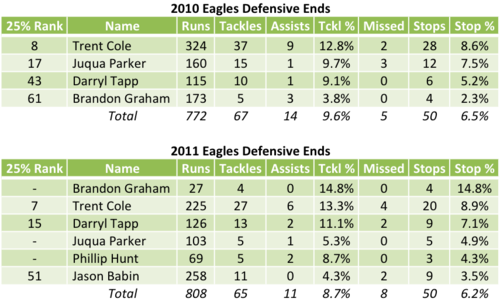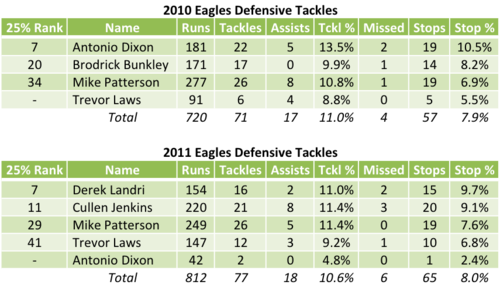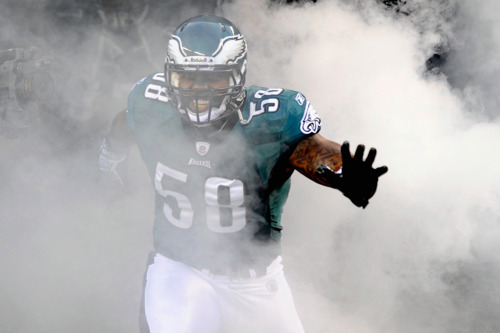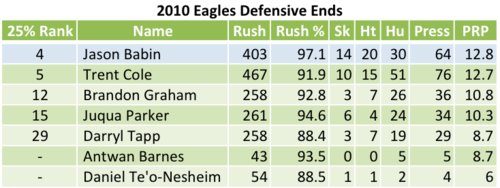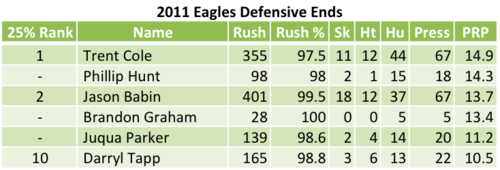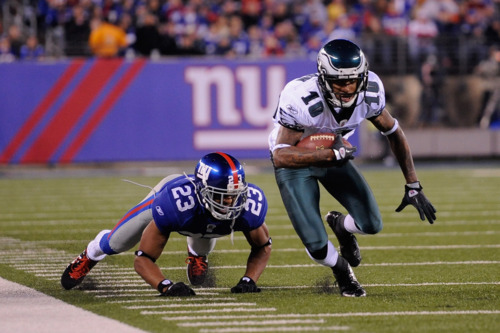On Monday, the Eagles parted ways with two veteran defensive tackles. The first, Cullen Jenkins, was a late-career mercenary hire in 2011, part of the free agent splurge that Joe Banner and company thought would put the team over the top. The other, Mike Patterson, was the longest-tenured Eagle, drafted with the team's first pick after the the Super Bowl. Neither cut was surprising; the new regime wants to get younger and less expensive.
However, the moves do give us an opportunity to step back and assess where the Eagles were coming from after last season and where they're going in the middle of the defensive line. Let's look at some 2012 stats, courtesy of Pro Football Focus:
The first two stats, Tackle % and Stop %, are about run defense: per snap, how often did the defensive tackle get in on the play and how often did he cause a stop. As you can see, the young guys led the group. Out of the 52 DTs with the most snaps, Fletcher Cox made the eighth-most tackles per play and the 12th-most stops. And that was only his rookie season. Cedric Thornton wasn't too far behind, posting above average numbers in both categories. While Mike Patterson barely played, the two other veterans Jenkins and Derek Landri logged more run snaps but came up short. Both players ranked toward the bottom in tackles and stops.
Moving over to pass rushing, we see that Jenkins played more of those downs than anyone and was still effective in that role, with the 14th-best Pass Rush Productivity rating (Pressure per play). However, the rookie Cox actually edged him out. In (mostly) Jim Washburn's scheme, Thornton and Landri were also reasonably effective. Both were above average out of the 69 most active pass rushers.
Alright, so that's where the team stood at the end of the season. What does it mean, and where do they go from here? With Patterson's injury keeping him off the field and no dead money on his contract, he was an easy cut. Landri didn't impress on tape or in the stats department and will be allowed to walk as a free agent. Jenkins requires slightly more explanation. Some people have suggested that his experience in the 3-4 would be valuable in 2013. But I'm not sure how much value he would actually have in Billy Davis' defense (or any 3-4). Jenkins still shows flashes as a pass rusher, but he was a liability against the run last year. This isn't someone the Eagles can stick at 5-technique defensive end.
What do the Eagles need from their defensive tackles? With the edge pressure positions likely filled through 2012 holdovers (Brandon Graham, Trent Cole) and the draft, the team needs a dominant inside pass rusher, a lane-clogging nose tackle, and a strongside all-around 3-4 end type. The inside one-gapping defensive tackle is an easy choice. That's Cox's role all the way. From the start he's been a fantastic rusher and run defender, and he should only get better. The nose tackle is a tougher position to fill. Returnee Antonio Dixon has the physical skills to play there, but there will certainly be other candidates brought in.
The question in my mind is Thornton. Jim Washburn liked him because he, like Cox, had inside pass-rushing skills. But breaking down the numbers, Thornton was actually a better run defender in his first extended NFL action. At 6'4", 309 lbs, he's a physically-gifted player. You could slot him in as Fletcher Cox's backup easily and hope that enables more pressure. But why not give him a shot at the 3-4 style strongside end? That position values run-stopping first, and Thornton can do that already. When the nose tackle comes off the field on passing downs, he can slide inside and provide interior pressure. With the old guys out of the way, that seems like a move that could maximize current talent in 2013 and beyond.
Photo from Getty.







